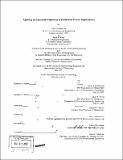Applying an analytical framework to production process improvement
Author(s)
Underwood, Curtis J. (Curtis James); Wood, Jacob R
DownloadFull printable version (9.508Mb)
Other Contributors
Leaders for Manufacturing Program.
Advisor
Stephen C. Graves and David Simchi-Levi.
Terms of use
Metadata
Show full item recordAbstract
As the medium voltage switchgear industry moves from air insulated to gas insulated technology, Siemens Frankfurt factory is introducing a new gas insulated product line that will improve their relative market position. It is their intent to design a product and supporting production system that will enable substantial cost and lead time reduction over existing Siemens gas insulated switchgear products. This thesis outlines a framework for analyzing the existing production process from 'customer order to customer delivery', identifying areas of opportunity, valuing projects aimed at achieving these opportunities, and prioritizing highest value projects for implementation. To provide a rigorous analytical approach to project selection, it was important to rethink existing ways of valuing inventory holding costs, material handling costs, and lead time. By uncovering hidden costs and benefits for each, projects that otherwise seemed unattractive become important to achieving overall factory objectives. Conversely, other projects that had been historically pushed by factory leadership were shown to generate little overall return on investment. (cont.) By using the approach outlined in this thesis, improved alignment was achieved across departments on several high value projects. This alignment positioned the factory to move forward with plans for successful implementation. It is the authors' hope that Frankfurt not only finalizes implementation of high value projects identified during this analysis, but also use the framework provided for future analysis and continued improvement.
Description
Thesis (M.B.A.)--Massachusetts Institute of Technology, Sloan School of Management; and, (S.M.)--Massachusetts Institute of Technology, Dept. of Civil and Environmental Engineering; in conjunction with the Leaders for Manufacturing Program at MIT, 2007. Includes bibliographical references (p. 74).
Date issued
2007Department
Leaders for Manufacturing Program at MIT; Massachusetts Institute of Technology. Department of Civil and Environmental Engineering; Sloan School of ManagementPublisher
Massachusetts Institute of Technology
Keywords
Sloan School of Management., Civil and Environmental Engineering., Leaders for Manufacturing Program.